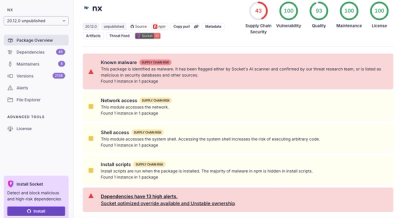
Security News
Risky Biz Podcast: Making Reachability Analysis Work in Real-World Codebases
This episode explores the hard problem of reachability analysis, from static analysis limits to handling dynamic languages and massive dependency trees.
scenebuilder-leading-edge
Advanced tools
This is a fork of Scene Builder for OpenJFX. This version includes early and yet unofficial features, which are still under development and in discussion at Github. We would be glad if you could share your feedback with the Scene Builder team at Github.
This version of Scene Builder is a fork of the most recent version of Gluons Scene Builder for OpenJFX. The difference to Gluon Scene Builder is, that this version has basically includes many of the open PRs and features. Hence curious users can use Scene Builder LE to explore and play with early and yet unofficial features.
Often it is hard to judge how a feature feels and how it works. This for shall allow exploration of new functionality. This also means, that some features may also get remove if it turns out that they do not work in the intended way or in cases these features receive negative feedback.
This fork of Scene Builder can be installed and executed in parallel to an existing version of the mainline Scene Builder provided by Gluon.
ESC. by @luca-domenichiniInsets of custom controls if those are exposed as PropertyCMD++ or CMD+- on Mac and with CTRL++ or CTRL+- on Win/Linux. Also SHIFT+CMD and SHIFT+CTRL together with the arrow keys allows to zoom in/out.CTRL+P for showing the preview window was not working.Some open PRs are missing but those will follow soon.
Gluon Scene Builder is a drag and drop UI designer tool allowing rapid desktop and mobile app development. Scene Builder separates design from logic, allowing team members to quickly and easily focus on their specific aspect of application development.
Scene Builder works with the JavaFX ecosystem – official controls, community projects, and Gluon offerings including Gluon Mobile, Gluon Desktop, and Gluon CloudLink.
Scene Builder is open source, and it is freely licensed under the BSD license. Gluon can provide custom consultancy, training, and open source commercial support.
The best way to get started with Gluon Scene Builder is by downloading and installing on your developer machine the latest Scene Builder release.
See the documentation about the new features recently included.
For community support, go to StackOverflow.
Issues can be reported to the Issue tracker
Contributions can be submitted via Pull requests, providing you have signed the Gluon Individual Contributor License Agreement (CLA). Please check the contribution guide for more details.
Gluon Scene Builder is frequently released, and this is only required in case you want to fork and build your local version of Scene Builder.
These are the requisites:
Scene Builder makes use of the Maven Wrapper to build and run the project. So there is no need to install Maven on the developers machine. To utilize Maven Wrapper, instead of calling mvn, one can run ./mvnw on Linux or macOS or mvnw on Windows instead.
To build the Scene Builder services, on the project's root, run:
mvn clean package
Alternatively, utilizing the Maven Wrapper, one can run:
./mvnw clean package
It will create a partial shadow cross-platform jar under app/target/lib/scenebuilder-$version.jar, that doesn't include the JavaFX dependencies.
Before starting the app, all dependencies must be installed locally. This is achieved by:
mvn install
Then Scene Builder can be started with Maven:
mvn javafx:run -f app
Alternatively, you can run the partial shadow jar, providing you have downloaded the JavaFX SDK from here:
java
--module-path /path/to/javafx-sdk-$javafxVersion/lib \
--add-modules javafx.web,javafx.fxml,javafx.swing,javafx.media \
--add-opens=javafx.fxml/javafx.fxml=ALL-UNNAMED \
-cp app/target/lib/scenebuilder-$version.jar \
com.oracle.javafx.scenebuilder.app.SceneBuilderApp
To build and install the Scene Builder Kit in your local repository, run:
mvn clean install -f kit
The custom controls of the Scene Builder kit can be used in your project. You can add it as a regular dependency to the build of your app:
<dependency>
<groupId>com.gluonhq.scenebuilder</groupId>
<artifactId>kit</artifactId>
<version>$version</version>
</dependency>
To ensure that new code formatting matches the requirements for Pull Requests, the Maven Checkstyle plugin can be used to create a report listing possibly coding style violations.
Contributors can check for code-style violations in their code by running the Checkstyle Maven goal. The checkstyle configuration is currently in a very early stage and only checks for empty blocks, extra white space, padding and empty lines.
To run the plugin:
mvn checkstyle:checkstyle
There will be a report for each sub-project, one for app and one for kit.
kit/target/site/checkstyle.htmlapp/target/site/checkstyle.htmlThis project makes use of EditorConfig which is directly supported by IntelliJ IDEA. There are plugins for NetBeans, Eclipse and Visual Studio and more. EditorConfig ensures via configuration in .editorconfig file, that the proper indentation is used.
EditorConfig can automatically correct possible formatting violations when executed as a Maven plug-in: mvn editorconfig:format.
9929b0830fbe340931dd9c5bc58a75168ab9a21442641445bf9d05d818a03830
FAQs
This is a fork of Scene Builder for OpenJFX. This version includes early and yet unofficial features, which are still under development and in discussion at Github. We would be glad if you could share your feedback with the Scene Builder team at Github.
The npm package scenebuilder-leading-edge receives a total of 6 weekly downloads. As such, scenebuilder-leading-edge popularity was classified as not popular.
We found that scenebuilder-leading-edge demonstrated a not healthy version release cadence and project activity because the last version was released a year ago. It has 1 open source maintainer collaborating on the project.
Did you know?

Socket for GitHub automatically highlights issues in each pull request and monitors the health of all your open source dependencies. Discover the contents of your packages and block harmful activity before you install or update your dependencies.

Security News
This episode explores the hard problem of reachability analysis, from static analysis limits to handling dynamic languages and massive dependency trees.

Security News
/Research
Malicious Nx npm versions stole secrets and wallet info using AI CLI tools; Socket’s AI scanner detected the supply chain attack and flagged the malware.

Security News
CISA’s 2025 draft SBOM guidance adds new fields like hashes, licenses, and tool metadata to make software inventories more actionable.